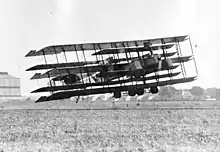Johns Multiplane
The Johns Multiplane was a very large unsuccessful experimental aircraft having seven wings and six ailerons, powered by three Liberty L-12 V-12 aircraft engines. The machine had the appearance of a biplane spliced onto the front of a triplane with two wings added at the rear. The center fuselage housed the cockpit and one engine in tractor configuration. Both side booms ended with wing-mounted engines in pusher configuration. The aileron control force was found to be extremely high.
| Multiplane | |
|---|---|
 | |
| Johns Multiplane ready for testing circa 1919 | |
| Role | Experimental aircraft |
| Manufacturer | American Multiplane Co. |
| Designer | Herbert Johns |
| First flight | 1919 |
| Status | Scrapped |
| Number built | 1 |
Design and development
Designed by Herbert Johns of the American Multiplane Company in Bath, New York, Patent # 1,365,995 Flying Machine was granted to Charles A. Herrmann, also of the American Multiplane Company on Oct. 3, 1916.[1]
Operational history
The massive septi-wing made a series of short hops during testing, but was eventually scrapped in 1920[2] due to its inability to maintain controlled flight.

Specifications
General characteristics
- Crew: three
- Length: 55 ft 9 in (17 m)
- Wingspan: 106 ft 4 in (32.4 m)
- Powerplant: 3 × Liberty L-12 water-cooled 45° V-12 piston engine, 400 hp (300 kW) each
Performance
References
- "Official Gazette of the United States Patent Office". 282: 461. Retrieved 1 March 2015. Cite journal requires
|journal=(help) - Aviation History, Nov 2010 page 11